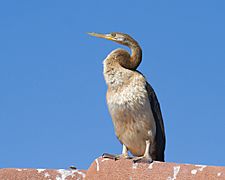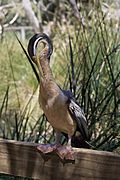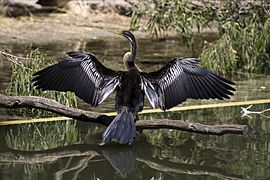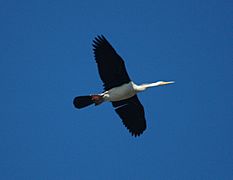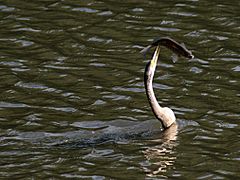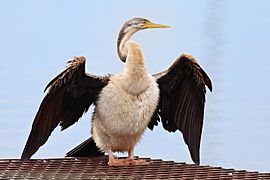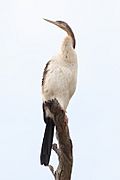Australasian darter facts for kids
Quick facts for kids Australasian darter |
|
|---|---|
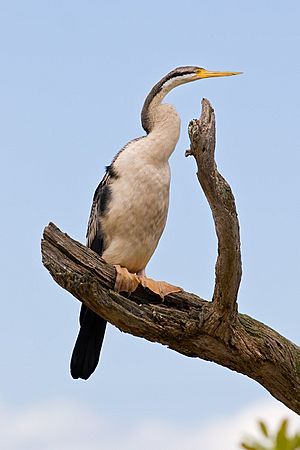 |
|
| Australasian darter (female), Anhinga novaehollandiae | |
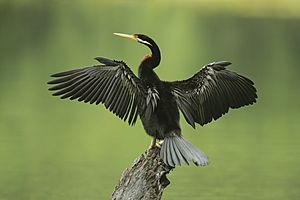 |
|
| Male | |
| Conservation status | |
| Scientific classification | |
| Genus: |
Anhinga
|
| Species: |
novaehollandiae
|
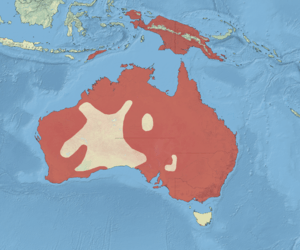 |
|
| Distribution map | |
| Synonyms | |
|
Anhinga laticeps (De Vis, 1906) |
|
The Australasian darter (Anhinga novaehollandiae) is a special type of bird known for its amazing diving skills. It belongs to the darter family, Anhingidae. This bird lives in countries like Australia, Indonesia, and Papua New Guinea. It usually weighs about 2.6 kilograms and measures 86 to 94 centimeters long. People sometimes call it a "snake-bird" because of its long, thin neck.
Contents
What is the Australasian Darter?
The Australasian darter was first officially described by a scientist named John Gould in 1847. It is closely related to other darters found in America, Africa, and Asia. For a while, scientists wondered if they were all the same species or different ones. Today, most agree that the Australasian darter is its own unique species.
People have many common names for this bird. Some call it a darter, diver, or even a snake-bird. The Noongar people, who are Indigenous Australians from the southwest, call it mimal.
How to Identify an Australasian Darter
The Australasian darter is a slender bird, measuring about 86 to 94 centimeters long. It has a very thin neck that looks a bit like a snake.
- Males: Male darters have black feathers. They also have a clear white stripe running down the side of their head and neck.
- Females: Female darters have white feathers on their underside.
Where Do Australasian Darters Live?
Australasian darters prefer to live in freshwater or brackish (slightly salty) wetlands. These places usually have water that is deeper than 0.5 meters. They like areas with fallen trees or logs and banks covered in plants. Sometimes, they can also be found in saltwater areas inland.
You can find this bird in the lowlands of New Guinea, New Britain, the Moluccas, and the Lesser Sunda Islands. In Australia, they live across most of the country. However, you won't find them in very dry places like the Great Sandy Desert, Great Victoria Desert, or the Nullarbor Plain. They are rarely seen in Tasmania.
What Do Australasian Darters Eat?
The Australasian darter hunts for food in the water. Often, you will only see its head and neck sticking out of the water. Its feathers can soak up water, which helps the bird become less buoyant. This allows it to swim easily underwater.
They eat a wide variety of fish, including:
- Australian smelt
- Bony bream
- Queensland mouth breeder
- Surf bream
- Spangled perch
- Flathead gudgeon
- Introduced fish like redfin perch, goldfish, and carp
They also eat other animals, such as:
- The New Guinea snake-necked turtle
- Freshwater shrimp
- Worms
- Cephalopods (like squid or octopus)
- Many kinds of insects, including flies, moths, water scavenger beetles, water beetles, water boatmen, giant water bugs, and backswimmers.
How Do Australasian Darters Breed?
Australasian darters build their nests and raise their young throughout the areas where they live. They usually breed near fresh or inland saltwater bodies. Most of the time, they breed once a year. However, if there are two floods in one year, they might breed twice.
- When they breed:
- In southern Australia, breeding happens in spring (August to October).
- In northern Australia, it's during the wet season (January to March or April).
- In parts of New Guinea, it can be in April, or between July and November.
- Nests: Their nest is a large, wide, dish-shaped structure. They build it using sticks and line it with reeds, leaves, and rushes. Nests are often placed in the branches of a tree that is partly underwater or hanging over the water. Darters sometimes build their nests in colonies with cormorants. You can tell a darter's nest apart because it's usually bigger and doesn't have as much guano (bird droppings) on it.
- Eggs: Females lay three to five eggs. The eggs are oval-shaped and measure about 56 by 34 millimeters. They start as a pale blue color but are covered in a chalky white layer. Over time, as the eggs are incubated, they become scratched and stained.
Various views and plumages
See also
 In Spanish: Aninga australiana para niños
In Spanish: Aninga australiana para niños



